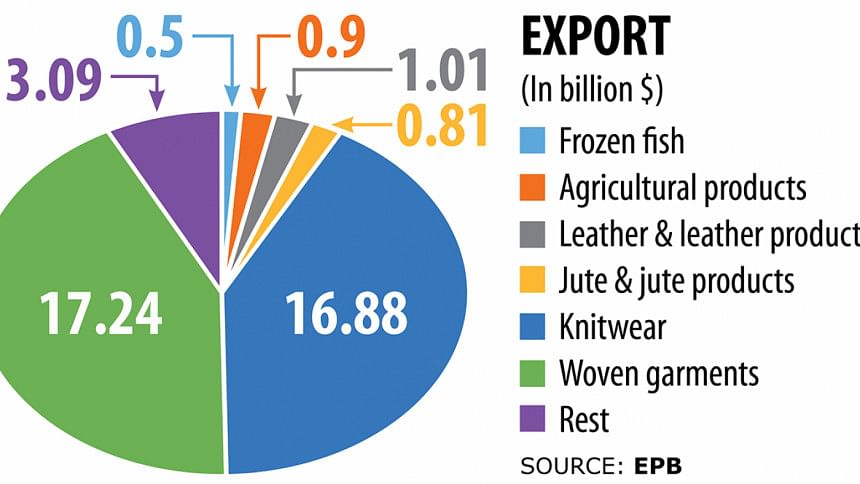Double-digit export growth in FY19

The country's merchandise export earnings grew by 10.55 percent year-on-year to $40.53 billion in the immediate past fiscal year riding on a high volume of garment shipment in a favourable external business environment.
The earnings were 3.94 percent higher than the annual target of $39 billion in 2018-19. In 2017-18, Bangladesh exported goods worth $36.66 billion.
However, June recorded one of the lowest export receipts at $2.78 billion, which is also 5.27 percent less than that of the corresponding month in the previous fiscal year, according to Export Promotion Bureau (EPB) data released yesterday.
In June of 2017-18, Bangladesh's export earnings were $2.93 billion.
June's receipts were also 22.65 percent lower than the monthly target of $3.60 billion set by the government. In Bangladesh, the fiscal year is counted between July of a year and June of the next year.
Garment export earnings, which accounted for over 84 percent of the national exports, amounted to $34.13 billion, registering an 11.49 percent year-on-year growth.
Of the amount, $16.88 billion came from knitwear and $17.24 billion from woven garment products.
Earnings from apparel shipment were 4.57 percent higher than the target of $32.68 billion. Some $30.61 billion was earned in fiscal 2017-18.
"The earnings from June indicate that the future trend is not so good for the garment sector," said Faisal Samad, vice-president of the Bangladesh Garment Manufacturers and Exporters Association (BGMEA), over the phone.
Although garment shipments grew by 11.49 percent, international retailers and brands are not paying higher prices while purchasing garment items from Bangladesh, he said.
However, Bangladesh is getting more work orders that shifted from China resulting from the US-China trade war, Samad said. Buyers are more confident as the image of the country's garment sector has brightened a lot recently because of the remediation carried out as per requirements of the international community.
The country's garment export to the US market, the single largest export destination for garment, grew more than 10 percent in recent months because of the trade war, he said.
"The exact value addition has not been reflected in the offered prices for Bangladeshi garment items by the international clothing retailers and brands although the cost of doing business is increasing every year for various reasons," Samad said.
Moreover, an unhealthy price competition has been hurting the Bangladesh's garment sector for many years as many small and medium factories have been receiving work orders for offering prices below the production cost only to keep factories running, he added.
Apart from apparel, some other sectors also fared well.
The shipment of frozen and live fish such as shrimp and crabs rose 1.58 percent to $500.4 million and that of agricultural products such as tea, vegetables, fruits, spices, dry food, and tobacco surged 34.92 percent to $908.96 million.
Pharmaceuticals, furniture, petroleum byproducts, plastic goods, ceramics, handicrafts, cotton, cotton products (yarn and wastes of fabrics), carpet, terry towel, footwear, wigs, and furniture performed better in the last fiscal year.
However, leather and leather goods and jute and jute goods continued their poor show. Leather and leather goods fetched $1.01 billion, down 6.06 percent year-on-year. This is largely because many tanneries that have shifted to the leather estate in Savar have not embarked on full-fledged production yet.
The sector is the only segment that had crossed the $1-billion export mark after garments last year. Exports of jute and jute goods, another important foreign currency earner, fell 20.41 percent year-on-year to $816.27 million.
The sector's earnings are declining mainly because of higher use of jute goods like sacks in the domestic market and the anti-dumping duty slapped by India.
Home textiles, building materials, ships and bicycles also performed poorly.

 For all latest news, follow The Daily Star's Google News channel.
For all latest news, follow The Daily Star's Google News channel. 





Comments